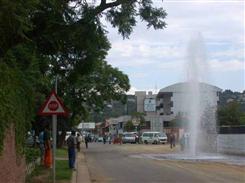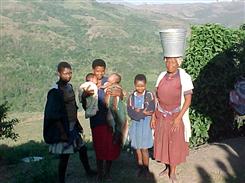Urban water use is often grouped with industrial water use because urban centres are often near industrial centres. Similarly, rural water use is sometimes grouped with livestock watering requirements, again because of the proximity of the activities. Both urban and rural water uses include domestic water needs.
The demand for water in urban and rural areas is mainly influenced by:
-
Population (including growth and density)
-
Cost of water services and their development
-
Technological choices based on the socio-economic situation of water users
-
Climate
In the Orange-Senqu River basin there is disparity in water availability between countries, with the development of water supply infrastructure lacking in rural, semi-urban and even some small urban areas. This situation has been aggravated by the movement of the rural population towards urban settlements, resulting in numerous informal settlements without water supply or sanitation facilities. A further movement of internally displaced persons moving away from difficult living conditions in neighbouring countries, has added to pressure on water demands in urban areas.
As discussed in Water Demand Management,Namibia and South Africa have decentralised water successfully, shifting management from the national levels to the catchment or community level. In Botswana, decentralisation has occurred to a certain degree and in Lesotho, though water supply is currently the responsibility of government, the most successful water schemes have been found where communities are actively involved in the management of the scheme.
Threats to Water Quality
Many rural settlements in the Orange-Senqu River basin are not equipped with proper sanitation facilities, and the most common sewerage infrastructure type found in rural areas is the septic tank. Septic tanks and improper sanitation facilities can release harmful nutrients into the groundwater table and possibly surface water channels. These nutrients can lead to the spread of disease and can harm the aquatic environment through eutrophication. Sewerage releases are not solely a rural problem; poorly managed urban treatment facilities can permit releases with similar effects, but at a greater scale and the potential to impact more people.
Stormwater runoff from urbanised areas carries pollutants directly into the streams, rivers and lakes that people depend on for potable water:
-
Sediment
-
Oil, grease, and toxic chemicals from motor vehicles
-
Pesticides and nutrients from lawns and gardens
-
Viruses, bacteria, and nutrients from pet waste and failing septic systems
-
Heavy metals from motor vehicles, and other sources
These pollutants can harm the biota in aquatic environments, kill vegetation, contaminate drinking water supplies, and make recreational areas unsafe and unpleasant (Stormwater 2009). To protect surface water quality and groundwater resources, infrastructure in urban areas should minimise runoff generation.
The Rural and Urban water use in the different water management areas of the basin are discussed in the following pages:
 Leaking water pipes account for huge water losses. Source:McKenzie 2008 ( click to enlarge ) |
 Meeting rural water requirements. Source:DWAF 2002 ( click to enlarge ) |
